Demand for FAKE meats is growing; why not eat REAL meat?
The Salt blog on NPR.com says in its article Meat Substitute Market Beefs Up: “110 new meat substitute products were introduced in 2010 and 2011 . . . giving people who are looking for tasty alternatives to meat a lot more choice.” So if these products are not real meat, then what are they and why is demand increasing? This article never says what they are made of, just calls them “veggie burgers” and “fake meat products.” The closest the Salt comes to identifying the ingredients in these products is in the chosen photo of seitan (made from wheat gluten) accompanying the story.
I’ve already written about an animal fat substitute made from cellulose incorporated into an oleogel [Coming soon, the ‘Frankenfurter’–ethylcellulose in the oleogel!]; however, the oleogel didn’t replace all the meat, only some of the animal fat. I decided to find out what kinds of fake meats there are and how they’re made.
Wikipedia says that “A meat analogue, also called a meat substitute, mock meat, faux meat, or imitation meat [what about just fake meat?], approximates the aesthetic qualities (primarily texture, flavor, and appearance) and/or chemical characteristics of specific types of meat. Many analogues are soy-based . . .” The most common types of fake meat include tofu, tempeh, textured vegetable protein (TVP), wheat gluten or seitan (as pictured in the NPR article), and Quorn. Let’s look at what they are and how they’re made.
Tofu
Tofu, also called bean curd, is made by coagulating soy ‘milk’ and pressing the resulting curds into blocks. Soy ‘milk’ is made by soaking, grinding, boiling, and straining dried soybeans. Although most tofu available in our markets is not fermented, there is a variety of tofu, called pickled tofu, that is fermented by allowing cubes of fresh tofu to “air-dry under hay and slowly ferment from aerial bacteria” after which it is soaked in a mixture of salt water, wine, vinegar, and flavorings. Another version of fermented tofu, called stinky tofu [and it probably does, too], is made with soft tofu fermented in a vegetable and fish brine. Special note here: since most commercial tofu available in U.S. markets is not fermented, it would have the health problems found in other unfermented soy foods.
Tempeh
Tempeh is a soy product that originated in Indonesia probably in the 1800’s. To make tempeh, the soybeans are naturally cultured and fermented into a cake form. The fermentation gives tempeh more protein, vitamins, and fiber, as well as an earthy flavor. It also makes the soy carbohydrates more digestible and reduces the phytic acid. Wikipedia says that in Western countries, the tempeh may have little B12 due to the choice of culturing agents.
Textured Vegetable Protein (TVP)
TVP–also called textured soy protein (TSP), soy meat, or soya meat–is made from soy flour after the oil has been extracted. Here’s the process for making TVP:
It is extruded into various shapes (chunks, flakes, nuggets, grains, and strips) and sizes, exiting the nozzle while still hot and expanding as it does so.[3] The defatted thermoplastic proteins are heated to 150-200°C, which denatures them into a fibrous, insoluble, porous network that can soak up as much as three times its weight in liquids. As the pressurized molten protein mixture exits the extruder, the sudden drop in pressure causes rapid expansion into a puffy solid that is then dried. As much as 50% protein when dry, TVP can be rehydrated at a 2:1 ratio, which drops the percentage of protein to an approximation of ground meat at 16%.
. . .
Many TVP producers use hexane to separate soy fat from soy protein, and trace amounts of the solvent are left after manufacturing.
Where is TVP used? It’s often used as a meat extender by food service, retail facilities, and institutions such as schools and prisons. Why is it used? Because it’s cheap and has a long shelf life. BTW, even a very pro-TVP website added this caveat: “TVP can create some gas. Beano would help.” It also claims that “your body will get used to it.”
Wheat gluten/Seitan
Wheat gluten–also called seitan, wheat meat, mock duck, gluten meat, or gluten–“is made by washing wheat flour dough with water until all the starch dissolves, leaving insoluble gluten as an elastic mass which is then cooked before being eaten.” It can have a chewy or stringy texture that makes it resemble real meat more than other fake meats such as TVP or tofu. Seitan was developed about 1962 by a macrobiotic teacher as a salty seasoning for brown rice but the name has gradually come to refer to any wheat gluten. Wheat gluten is used in commercial products by Morningstar Farms and Tofurkey. Wheat gluten can also be used as a protein source in pet foods and was associated with the 2007 melamine-contaminated Chinese pet food recalls.
Quorn
Quorn is a brand of lab-created fake meat “made from the soil mould Fusarium venenatum . . .”The fungus is “grown in continuously oxygenated water in large, otherwise sterile fermentation tanks. Glucose is added as food for the fungus, as are vitamins and minerals to improve the food value of the product. The resulting mycoprotein is then extracted and heat-treated . . .” The product is dried and mixed with egg albumen, which acts as a binder. It is then textured, giving it some of the grained character of meat, and pressed either into a mince resembling ground beef; forms resembling chicken breasts, meatballs, and turkey roasts; or chunks resembling diced chicken breast.There has been some controversy over advertising for Quorn that claimed it was “mushroom-based.” The fungus that produces Quorn is not a mushroom.
Update September 27, 2014: “Safety Questions Loom Over Quorn Brand Meat Substitute.” “Reported adverse effects from Quorn include nausea, cramps, diarrhea, forceful vomiting, and anaphylactic reactions.”
Vegetarian cutlet
This fake meat, vegetarian cutlet, is a new, lab-created one not yet on the market (maybe later in 2012). As opposed to the hot extrusion process for making TVP, this new cutlet is made by slowly boiling and then slowly cooling water and plant proteins. “As the temperature sinks, the protein molecules start to form chains. This gives rise to a fibrous structure that is quite similar to that of meat.” The proteins can be made from a variety of plants, including wheat, peas, lupins, or soybeans. The team at Fraunhofer Institute for Process Engineering and Packaging IVV that developed this fake meat is still working on improving the flavor, but they claim that the consistency and texture are “already superb.” We can only imagine the additives and flavoring agents that will be put into this product to make it taste good. Do you really believe it will be a healthy food when they’re done? The vegetarian cutlet will be debuted at the Anuga FoodTec fair in Cologne in March 2012.
Update added June 20, 2012:
Veggie Chicken Strips
As of June 2012, there’s a new type of fake meat on the market, made by Beyond Meat ™. This one is absolutely NOT REAL FOOD. There’s nothing natural, traditional, or healthy about it.
Here are the ingredients:
Water, Soy Protein Isolate, Pea Protein Isolate, Amaranth, Chicken Flavor (Maltodextrin, Yeast Extract, Natural Flavoring), Soy Fiber, Carrot Fiber, Expeller-Pressed Canola Oil, Dipotassium Phosphate, Titanium Dioxide, White Vinegar
And here’s how it’s made:
The facility is what Brown [founder of Beyond Meat ™] calls the modern farm. It smells like chicken soup, but there are no animals here. Except for the hum of various heating and processing machines, it’s quiet. It looks more like a lab than a kitchen. . . . Milstead’s [Beyond Meat ™ employee] bucket contains a dry mix of soy and pea powder, carrot fiber and gluten-free flour. Through a process the company licensed exclusively from the University of Missouri, the mix is cooked, cooled and extruded through a customized machine. . . .Brown stands at the other end of the machine, pulling out chunks of pale white strips that tear like cooked chicken. The entire process — from powder to product — takes about 15 seconds. [emphasis mine]
Here’s why it’s made:
Ethan Brown, the founder of Beyond Meat, became a vegan out of concern for animals’ welfare but was “frustrated by ‘fake meat’ options available.” He bought exclusive licensing rights for the process from a biological engineering professor at the University of Missouri. Producing the new fake meat requires a facility that can subject the powdered ingredients to very high heat, extrusion, and quick cooling. “It looks more like a lab than a kitchen.” And, the process takes only 15 seconds–how’s that for extreme processing? Could we make this at home? Absolutely not! Would we want to?
There is apparently no pretense that the product is anything other than fake. Advertising says that it “will fool your taste buds.” The employees admit they make ‘fake chicken.’ In addition to extreme processing and lack of real food ingredients, this new fake meat has all the problems with soy that are described below. Although the product seems to be aimed at vegans, many vegans said that they did not approve of this or any other fake meat or fake food, calling it vegan junk food. They wanted to eat real, but plant-based only, foods. Most comments from those who have tried the new product said that it tasted like chicken, but, since it’s bland, it’s best when used with other flavorful ingredients, like in curries or salads. The company promises fake beef in the near future.
What are some of the problems with fake meat?
Well now that we know what some of these fake meats are and how they’re made, should we eat them? Let’s look at the soy-based fake meats first–tofu, tempeh, and TVP. First question: how important is your health? Eating soy can cause potentially significant health problems. Here are some of them, from Soy Alert! on the Weston A. Price Foundation website (the website has links to many studies about the adverse effects of soy):
- High levels of phytic acid in soy reduce assimilation of calcium, magnesium, copper, iron and zinc. Phytic acid in soy is not neutralized by ordinary preparation methods such as soaking, sprouting and long, slow cooking. High phytate diets have caused growth problems in children.
- Trypsin inhibitors in soy interfere with protein digestion and may cause pancreatic disorders. In test animals soy containing trypsin inhibitors caused stunted growth.
- Soy phytoestrogens disrupt endocrine function and have the potential to cause infertility and to promote breast cancer in adult women.
- Soy phytoestrogens are potent antithyroid agents that cause hypothyroidism and may cause thyroid cancer. In infants, consumption of soy formula has been linked to autoimmune thyroid disease.
- Vitamin B12 analogs in soy are not absorbed and actually increase the body’s requirement for B12.
- Soy foods increase the body’s requirement for vitamin D.
- Fragile proteins are denatured during high temperature processing to make soy protein isolate and textured vegetable protein.
- Processing of soy protein results in the formation of toxic lysinoalanine and highly carcinogenic nitrosamines.
- Free glutamic acid or MSG, a potent neurotoxin, is formed during soy food processing and additional amounts are added to many soy foods.
- Soy foods contain high levels of aluminum which is toxic to the nervous system and the kidneys. [The aluminum content of processed soy is increased by the acid washing in aluminum tanks.]
Another problem with soy-based fake meats–mentioned above under TVP–is that “Makers of many soy-based burgers submerge the soybeans in hexane to separate the oil from the protein and reduce the amount of fat in the product. If a non-organic burger contains soy protein isolate, soy protein concentrate, or texturized vegetable protein, it was likely made using hexane.” Some burger brands made with hexane are Amy’s Kitchen, Boca Burger, Garden Burger, Morningstar Farms, Trader Joe’s, and Yves Veggie Cuisine. Hexane is prohibited in organic food but not prohibited in food labeled “made with organic ingredients.” [Update April 18, 2012: Guide to hexane-extracted soy in meat alternatives.] Although the fermentation process for tempeh increases the nutrition and digestibility and decreases the phytic acid, it does not remove the phytoestrogens. Another major issue with soy-based fake meats: if your soy product–tofu, tempeh, or TVP–is not organic then it’s probably genetically engineered.
Well, so much for soy as a healthy food. What about Quorn and seitan? One of the biggest problems some people have with Quorn is what it’s made of, a soil mold fungus, a substance that can’t be white-washed by calling it mushroom-based. There have been some reports of reactions to eating Quorn. Another major problem for Quorn is the use of egg white as a binder which makes it unsuitable for vegans, who are among the prime targets for any fake meat product. As for seitan, a serious drawback for many people is that it is made of wheat gluten, which can’t be tolerated by those with celiac disease, wheat allergies, or gluten sensitivity. In addition, there is increasing evidence that wheat gluten can cause health problems for people who don’t exhibit obvious symptoms of gluten sensitivity. The issue of fake meats really boils down to one fact: most of them are lab-created,–they are fakes, not REAL FOOD. I liked the way one vegan food writer described fake meat: “making analog meat is a lot more like making Twinkies than making sausage. You’re basically running plant-based ingredients through a giant machine.” Most fake meats are lab-created and machine-made.
If there are so many health problems with fake meats, why do people choose to eat them?
When we talk about fake meats, especially when we see the many health problems associated with them, we need to look at why people choose to eat them. There are many reasons, including religious beliefs, philosophical beliefs, vegetarianism, and veganism. Many of these beliefs have been with us for centuries, but I think one of the main reasons the demand for fake meat is increasing now is the mistaken but wide-spread belief that abstaining from meat is somehow healthy; sometimes vegetarianism is even equated with being health-conscious. As just one example, many people believe that eating meat, especially red meat, causes high cholesterol levels and heart disease. Although more attention is now focused on the research showing that eating meat (or any dietary cholesterol or natural saturated fat) is not related to heart disease, it’s a slow process to change a course that has been heavily, if inaccurately, promoted by the medical profession and the government for decades. There are too many problems associated with veganism and vegetarianism to cover in this post, so if you want to know more, look below under Sources: Problems with Veganism and Vegetarianism.
My solution: Eat REAL FOOD, eat REAL MEAT!
So what are to do? Well, in my opinion, it’s always best to eat real, traditional foods. Of the above fake meats, probably the only ones that we could justify eating, even occasionally, are those that have been eaten for many years, like tofu (thousands of years), or those that have been fermented to enhance nutrition, like tempeh, but, as noted above, even these soy-based products have a downside. It’s hard to see any reason to eat lab-created fake meats like TVP, Quorn, or vegetarian cutlet–they are truly fake foods. What does that leave for us to eat? I think the solution is to eat real, humanely raised and traditionally prepared meat such as grassfed beef and chicken, lamb, and pork raised naturally in pasture. Joel Salatin best explains the necessity of animals to farming in his latest book, Folks, This Ain’t Normal:
With our frame of reference skewed, our perceptions about farming, and our notions of what is environmentally enhancing or not, we approach farming with prejudicial brain damage. As a result, we have environmentalists spouting the ignorant notion that cows are belching methane and causing global warming. The scientific studies impugning the cow view her as taking, taking, taking and not putting anything back.
. . .
The cow, perhaps more than anything else, represents civilization. . . Ecologically, the cow restarts the photosynthetic biomass accumulation process. . . Without the herbivore, the forage would grow to senescence, fall over, and oxidize CO2 into the atmosphere. . . Throughout history and worldwide, the herbivore reawakens biomass, stimulating it to greater solar activity.
When farmers divorce the herbivore from fulfilling this ecological function, it cannot perform the positive function it is supposed to.
. . .
Because some people use the cow abusively by denying this normal role is not reason to demonize the cow any more than it would be proper to eliminate automobiles because someone drives one recklessly. Not a single long-term tillage system on earth exists without an herbivorous component. You can’t just substitute tofu (made from tillage–soybeans) for the herbivore. It doesn’t work ecologically. Period. No matter how much you like tofu.
This is perhaps one of the biggest misunderstandings people have about farming ecology. In a desire to get rid of the cow, they want to substitute plants that require tillage. No long-term example exists in which tillage is sustainable. It always requires injection of biomass from outside the system or a soil-development pasture cycle. To think that plants which require tillage can build soil like perennial pasture indicates environmental absurdity.
There would soon be very few domestic animals on the earth if people stopped eating meat, milk, and eggs. There would be no economic reason to keep them, except maybe as pets. How many people would want to, or have enough land to, keep thousands/millions of cows, chickens, goats, and pigs as pets just to ensure the health of the earth? We need these animals just as they need us for our mutual survival.
Sources:
Meat Substitute Market Beefs Up, The Salt, NPR
‘Meat’ factory can make vegan substitute by the mile, msnbc.com
Meat analogue, Wikipedia
Soy Alert!, The Weston A. Price Foundation
The Whole Soy Story, Kaala Daniel
The Dark Side of Soy, Mary Vance Terrain
Newest Research on WHY You Should Avoid SOY Products, Sally Fallon & Mary G. Enig, Ph.D.
Which Veggie Burgers Were Made With a Neurotoxin, Joseph Mercola, M.D.
Hexane – Hazard Summary, U.S. EPA
Toxic Chemicals: Banned Organics But Common in “Natural” Food Production, The Cornucopia Institute
Medical Evidence Shows that Quorn Causes Adverse Reactions, CSPI
Juicy and Tender, Seitan Is Quite Possibly the Best Fake Meat–But There Is a Downside, by Anneli Rufus
Folks, This Ain’t Normal, Joel Salatin
Wheat Belly, William Davis, M.D.
The Perfect Health Diet, Paul Jaminet, Ph.D., and Shou-Ching Jaminet, Ph.D.
Sources: Problems with Veganism and Vegetarianism
Raw Food SOS: Troubleshooting on the Raw Food Diet, Denise Minger
The Weston A. Price Foundation: vegetarianism
Other posts you might want to read:
Analysis Shows No Association of Saturated Fat With Cardiovascular Disease
Study Shows Low Cholesterol in Women is Associated With Higher Death Rate
Warning! Women in danger of being overprescribed statins!
Study finds that GE toxins damage human cells
It’s Not Pretty Behind the Biotech Veil, an Interview with Howard Vlieger
Photo credits: Wikipedia
TVP flakes
Tofu at a Chinese market
Sliced tempeh
TVP chunks
Seitan
Quorn
Morningstar Farms veggie burger with portabella

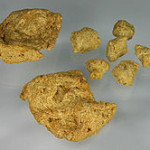

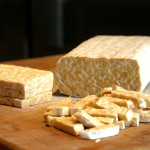
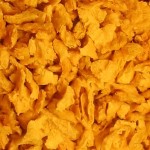
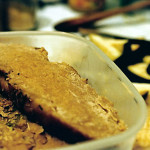

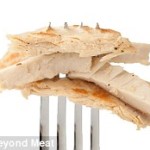
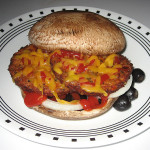
Would you ever eat meat completely raw? It is necessary to cook and prepare meat before it is safe to eat. Meat has to be processed to be edible. You don’t have to do that with plants. One of the many reasons an all-plant diet is superior to one that includes meat, no matter where it comes from.
I have eaten completely raw meat, although most of the meat I eat is cooked. It is safe to eat raw meat from healthy animals. I also drink raw milk and eat raw eggs, all from local farmers that I know personally. I don’t recommend eating factory-farmed animals or animal products either raw or cooked. However, most plant foods are easier for humans to digest if properly prepared and cooked.
Your previous comment included some inappropriate word choices such as name-calling; however, it has some good points and questions that I would like to respond to. If you want to resubmit your comment without those words, I will reply.
If you eat raw meat regularly then you most assuredly have worms. There are many parasites that live in healthy animals.
Pingback:Tofu hexane | Jameslegacy
I think your conclusion is very vague and not supported with environmental advantages or disadvantages. There is no division, for example between needs and choices of people in developing countries vs. developed countries… nothing is that simple.
Why not eat real meat? 99% of meat is produced from factory farming resulting in incalculable suffering PRIOR TO DEATH of non- human animals who experience pain & suffering the same as the human .primate re identical central nervous systems
We in the west who have no need for non- human animal protein have decided that the taste in our mouths is more important than the continuance agony of the innocents.
Can we then consider ourselves CIVILIZED? The arrogance of humanity is demonstrated
I agree that confined animal feed operation (CAFO) meat production is not only cruel to the animals but also destructive to our own health and our planet Earth; however, if you read the whole article, you noticed that I advocated the farming advice of Joel Salatin who has demonstrated that herbivores are required for healthy soil and, therefore, for our health. Humans are omnivores and animal foods are the best sources of many of the nutrients–not just protein–we need for health. We should practice humane methods of farming and animal care without the poisons, antibiotics, and inhumane conditions that are such a large part of conventional and CAFO farming.
CAFO produced meat should be avoided whenever possible, and we should promote changes that would reduce, preferably eliminate, factory farming.
For our health’s sake, all fake foods should be avoided, not just fake meat.
I’m not going to get into this, but to answer your question, very easily, which I’m shocked you couldn’t answer by yourself is
environmental damage. Animals rights. Ethics…morals…health ETC.
There is a rising demand because many people brought up on meat diets when they go on vegetarian/vegan diets it helps the transition for a start. People still like these products but might care for the environment or animals. Awareness of the damage eating animals causes is increasing, and as awareness increases, so will these products.
The current CAFO methods of animal farming are harmful to the animals and to those who eat the meat, dairy, or eggs produced by the animals; however, grasslands and herbivores are necessary for the health of the earth and for our health. As I mentioned in a previous reply, animal foods are the best sources for many nutrients that are essential for our excellent health. Humanely raised animals benefit the earth and therefore us. For example, cattle raised on grasslands, which is the normal environment for cattle, are carbon negative (http://grassbasedhealth.blogspot.fr/2012/08/cattle-emissions.html). That is not true of cattle raised in CAFOs.
Joel Salatin (http://www.joelsalatin.com/) is one of the best proponents for how to take care of the earth through humane farming. Eating foods from humanely raised pastured animals is not only not damaging to us or the earth, it is healthy and good for us and for the sustainability of our earth. What is far more damaging to the earth is the massive farming of rows and rows of vegetables, fruits, and grains–especially, but limited to, genetically engineered crops. Even organic large-scale farms (and most farms today are not organic) are not as good for earth’s sustainability as grasslands and herbivores.
Soy products have been used for thousand years in Asia, and older generation did not have much sickness or cancers . Here we are in the US, we eat more meat than everybody else, and hospitals are full of sick people. Drugs industry is one of the largest businesses in the US. Why don’t people open their eyes widely to see it?
Soy wasn’t eaten as food in Asia until the Chinese learned to ferment it as tempeh, natto, and tamari about 2 to 3 thousand years ago. Chinese people haven’t traditionally eaten much soy; it’s mostly used as a condiment. US people don’t necessarily eat more meat than people in other countries, but we may eat more CAFO meat which is unhealthy. We in the US also eat too much highly processed food that is lacking in nutrients. The pharmaceutical and health care business is one of the largest, it not the largest, businesses in the US, but that’s not the result of eating meat or too much meat.
Tofu, Seitan, and Tempeh are NOT fake meat. Tofu especially. These are foods that have been made for hundreds, if not thousands of years. These products are good for you and make no attempt to emulate meat. “Fake meats” like veggie burgers and hot dogs are greasy, contain tons of undesirable ingredients and are just as bad if not worse than their real counterparts. I wish everyone would stop lumping these foods together as “fake meat”.
Seitan and tempeh have not been made as long as many think. Tempeh was developed in Indonesia in the 1800’s. Seitan was a term coined in the 1900’s and was later associated with all wheat gluten products. The origin of wheat gluten derivatives is uncertain but probably was developed in China as a meat substitute for vegetarian Buddhists. One of its main uses today is mock duck. Tofu is an ancient food and can be a part of a healthy diet when eaten in limited amounts in the fermented form, which is difficult to find in the U.S. If eaten in larger quantities, for example as a meat substitute, tofu has many of the same problems as all soy foods. The article above has a list of some of the common problems with soy.
All of these products are used as meat substitutes, i.e., “fake meats,” and do not contain the nutritional benefits of meat from healthy sources.